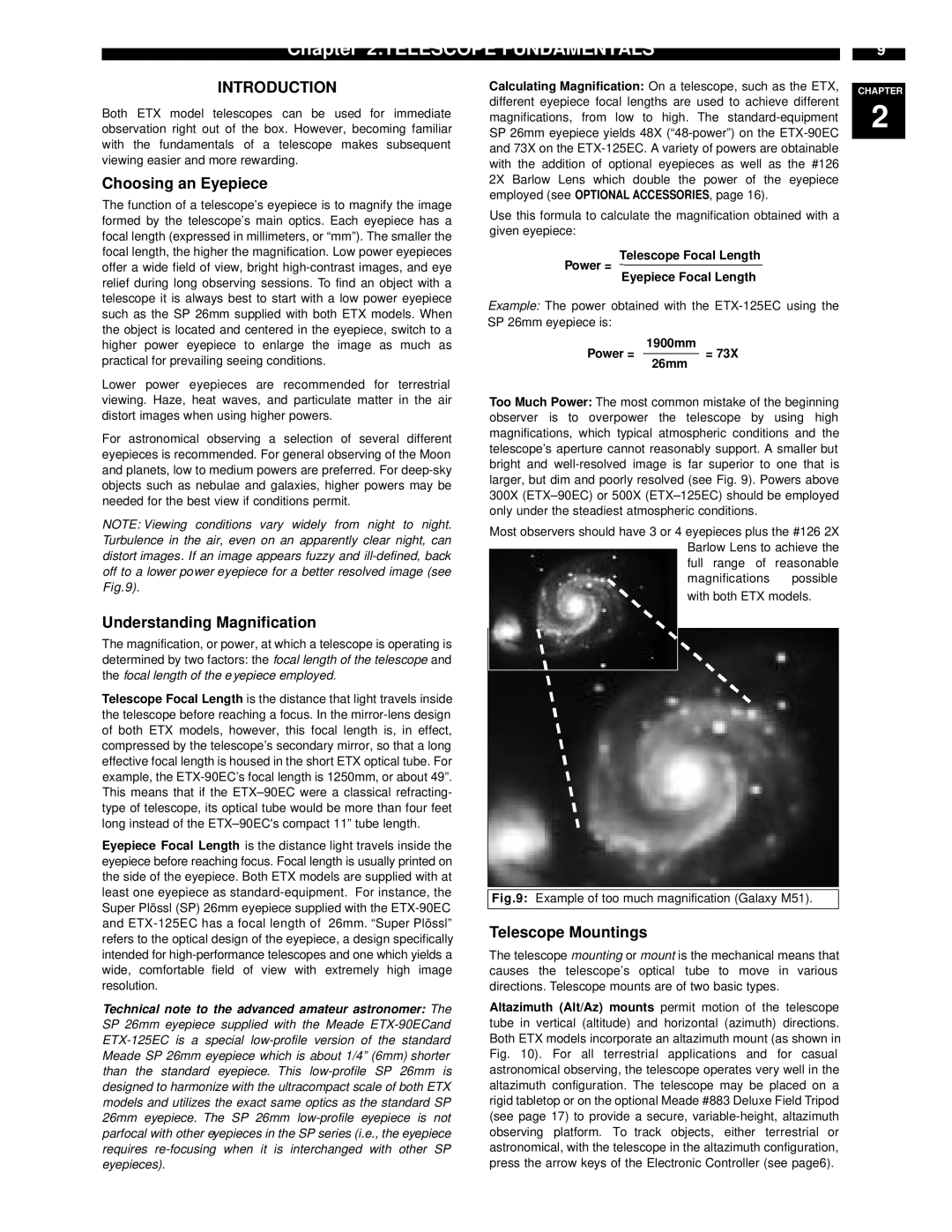INTRODUCTION
Both ETX model telescopes can be used for immediate observation right out of the box. However, becoming familiar with the fundamentals of a telescope makes subsequent viewing easier and more rewarding.
Choosing an Eyepiece
The function of a telescope’s eyepiece is to magnify the image formed by the telescope’s main optics. Each eyepiece has a focal length (expressed in millimeters, or “mm”). The smaller the focal length, the higher the magnification. Low power eyepieces offer a wide field of view, bright high-contrast images, and eye relief during long observing sessions. To find an object with a telescope it is always best to start with a low power eyepiece such as the SP 26mm supplied with both ETX models. When the object is located and centered in the eyepiece, switch to a higher power eyepiece to enlarge the image as much as practical for prevailing seeing conditions.
Lower power eyepieces are recommended for terrestrial viewing. Haze, heat waves, and particulate matter in the air distort images when using higher powers.
For astronomical observing a selection of several different eyepieces is recommended. For general observing of the Moon and planets, low to medium powers are preferred. For deep-sky objects such as nebulae and galaxies, higher powers may be needed for the best view if conditions permit.
NOTE: Viewing conditions vary widely from night to night. Turbulence in the air, even on an apparently clear night, can distort images. If an image appears fuzzy and ill-defined, back off to a lower power eyepiece for a better resolved image (see Fig.9).
Understanding Magnification
The magnification, or power, at which a telescope is operating is determined by two factors: the focal length of the telescope and the focal length of the e yepiece employed.
Telescope Focal Length is the distance that light travels inside the telescope before reaching a focus. In the mirror-lens design of both ETX models, however, this focal length is, in effect, compressed by the telescope’s secondary mirror, so that a long effective focal length is housed in the short ETX optical tube. For example, the ETX-90EC’s focal length is 1250mm, or about 49”. This means that if the ETX–90EC were a classical refracting- type of telescope, its optical tube would be more than four feet long instead of the ETX–90EC's compact 11” tube length.
Eyepiece Focal Length is the distance light travels inside the eyepiece before reaching focus. Focal length is usually printed on the side of the eyepiece. Both ETX models are supplied with at least one eyepiece as standard-equipment. For instance, the Super Plössl (SP) 26mm eyepiece supplied with the ETX-90EC and ETX-125EC has a focal length of 26mm. “Super Plössl” refers to the optical design of the eyepiece, a design specifically intended for high-performance telescopes and one which yields a wide, comfortable field of view with extremely high image resolution.
Technical note to the advanced amateur astronomer: The SP 26mm eyepiece supplied with the Meade ETX-90ECandETX-125EC is a special low-profile version of the standard Meade SP 26mm eyepiece which is about 1/4” (6mm) shorter than the standard eyepiece. This low-profile SP 26mm is designed to harmonize with the ultracompact scale of both ETX models and utilizes the exact same optics as the standard SP 26mm eyepiece. The SP 26mm low-profile eyepiece is not parfocal with other eyepieces in the SP series (i.e., the eyepiece requires re-focusing when it is interchanged with other SP eyepieces).
Calculating Magnification: On a telescope, such as the ETX, CHAPTER different eyepiece focal lengths are used to achieve different magnifications, from low to high. The standard-equipment 2 SP 26mm eyepiece yields 48X (“48-power”) on the ETX-90EC
and 73X on the ETX-125EC. A variety of powers are obtainable with the addition of optional eyepieces as well as the #126 2X Barlow Lens which double the power of the eyepiece employed (see OPTIONAL ACCESSORIES, page 16).
Use this formula to calculate the magnification obtained with a given eyepiece:
Telescope Focal Length
Power = ____________________
Eyepiece Focal Length
Example: The power obtained with the ETX-125EC using the SP 26mm eyepiece is:
1900mm
Power = ________ = 73X
26mm
Too Much Power: The most common mistake of the beginning observer is to overpower the telescope by using high magnifications, which typical atmospheric conditions and the telescope’s aperture cannot reasonably support. A smaller but bright and well-resolved image is far superior to one that is larger, but dim and poorly resolved (see Fig. 9). Powers above 300X (ETX–90EC) or 500X (ETX–125EC) should be employed only under the steadiest atmospheric conditions.
Most observers should have 3 or 4 eyepieces plus the #126 2X Barlow Lens to achieve the full range of reasonable magnifications possible with both ETX models.
Fig.9: Example of too much magnification (Galaxy M51).
Telescope Mountings
The telescope mounting or mount is the mechanical means that causes the telescope’s optical tube to move in various directions. Telescope mounts are of two basic types.
Altazimuth (Alt/Az) mounts permit motion of the telescope tube in vertical (altitude) and horizontal (azimuth) directions. Both ETX models incorporate an altazimuth mount (as shown in Fig. 10). For all terrestrial applications and for casual astronomical observing, the telescope operates very well in the altazimuth configuration. The telescope may be placed on a rigid tabletop or on the optional Meade #883 Deluxe Field Tripod (see page 17) to provide a secure, variable-height, altazimuth observing platform. To track objects, either terrestrial or astronomical, with the telescope in the altazimuth configuration, press the arrow keys of the Electronic Controller (see page6).

